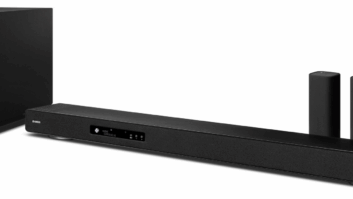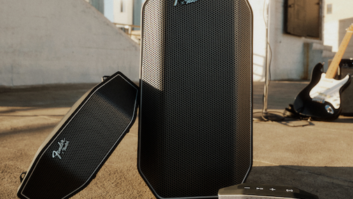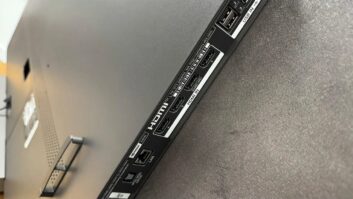Clearly, the most hyped new technology news to come out of the recent International CES was 3D TV.
Virtually all of the major manufacturers showcased new lines of 3D products slated for introduction this summer, and many of those same companies went a step further by enlisting help from content producers to provide native 3D source material for the new offerings through 3D-enabled Blu-ray Discs and the first 3D TV channels.
A few of the new sets will take another step up by processing regular 2D signal sources into stereoscopic 3D images, which can be viewed by the same active-shutter glasses used by most of the sets.
As you might expect, the impact and quality of such techniques does not match that of native 1080p 3D source material, but help fill in the content gap until more native 3D source material is produced.
While the home 3D TV trend was clearly telegraphed over the last 12 months, what did come as a pleasant surprise was how the new technologies in many of these systems will beneficially impact the image quality of 2D pictures as well.
In order to produce dual 1080p/240Hz images (in the case of 3D LCD TVs) for each eye, some manufacturers are adding powerful new processing chips and algorithms, which will not only render images in 3D, but produce cleaner, sharper up-converted 1080p pictures from lower-resolution signal sources.
The following is a glance at some of the new 3D TV lines that were unveiled at the show:
LG formally unveiled its new Infinia LED LCD TV assortment, highlighted by the 3D capable LE9500 series. That line, which will include the 47- and 55-inch screen sizes, stands out for having an ultra-slim (0.92 inches) panel depth using a full-array backlighting system. This allows the use of LG’s local-dimming technology to produce uniform brightness levels across the backplane, greater brightness and improved black levels, while using less power.
The 1080p TVs also include TruMotion 480Hz, NetCast Entertainment Access, DLNA compliance, two USB ports, wireless-HD connectivity and THX certification.
Panasonic’s first 3D plasma TVs will be offered in the V series, including the TC-PVT25 series, which is expected to include some of the first of the new 3D TVs on the market this spring. Screen sizes will include 50, 54, 58 and 65 inches and will come bundled with one pair of active-shutter 3D glasses. In producing a set that will deliver full 1080p resolution to each eye, Panasonic redesigned the plasma system for greater speed and resolution, while developing a new phosphor formulation that is said to improve picture quality for both 3D and 2D image sources.
The sets will carry THX certification; VieraCast broadband features delivering interactive content, including Skype HD video conferencing, Pandora, Twitter; optional Wi-Fi and ISFccc mode; and an RS-232 port.
Panansonic also showed its V25 series of FullHD 3D plasma TVs including the 50-inch TC-P50V25, which delivers 3D images in full 1080p resolution to each eye using high-speed 3D drive technology that enables rapid illumination of pixels while maintaining brightness. The set also features Viera Cast IP TV functionality, Eco link functions with Stand-by-Power, and Auto Power to minimize power consumption of connected devices, when power is turned off.
Samsung will offer several 3D TV series this year in both LCD and plasma. It’s flagship will be the LED9000 line, which will include 46- and 55-inch screen sizes measuring less than an inch thick.
The line includes Samsung’s proprietary 3D processor that supports several 3D standards, including half-resolution and FullHD formats, as well as the new Blu-ray 3D standard. The sets also include real-time processing of standard 2D images into stereoscopic 3D. Other features include built-in Wi-Fi 1080p resolution with 240Hz motion processing and a new touchscreen remote control that can show a separate program via Wi-Fi on the its LCD screen while watching a Blu-ray Disc or other signal source on the TV screen. For interactivity, Samsung also includes its Internet@TV service that can add a limitless supply of“apps” from the Samsung Apps store to deliver a variety of functions and features.
The UNC8000 series will also offer LED edge-lighting 1080p resolution with 240Hz motion processing and the company’s real-time 2D-to-3D content rendering. Screen sizes will include 46, 55, 60 and 65 inches.
The UNC7000 Series is Samsung’s entry line of LED 3D TVs. The TVs feature 2D-to-3D conversion, LED edge lighting and Internet TV options. Screen sizes will include 40, 46, 55, 60 and 65 inches.
Samsung is also planning to offer 3D through its PNC7000 series of plasma sets, which also include 2D-to-3D real time conversion, panel depths of 1.4 inches, Internet@TV and Samsung apps. Screen sizes and pricing were not available.
Sony introduced three series of FullHD 1080p/240Hz Bravia LED LCD TV sets. Highlighting the offerings is the XBR-LX900 series, which comes out this summer in 40, 46-, 52- and 60-inch screen sizes. All feature edge-lit LED lighting, Bravia Internet Video with integrated 802.11n Wi-Fi connectivity, 1080p resolution, Bravia Engine 3 picture processing, two active shutter glasses for 3D content and an emitter built into the sets’ bezels.
The 3D-ready XBR-HX900 series comes in 46- and 52-inch screen sizes, and the 3D glasses and emitter are optional. Features include full-array LED backlighting with local dimming, 1080p resolution, 240Hz Motionflow and Bravia Internet Video.
Sony’s LED KDL-HX800 series includes the 40-, 46- and 52-inch screen sizes with 3D capability. Glasses and emitter are sold separately. All use edge-lit LED back lighting with local dimming, 1080p resolution, 240Hz Motionflow and Bravia Engine 3 video processing.
Toshiba announced plans to market its first Cell TVs for the U.S. market based on the company’s powerful Cell processor. Two design series are planned, including the ZX900 Genesis series in 55- and 65-inch screen sizes, followed later by the Illusion series (46-, 55- and 65-inch screen sizes).
The TVs, which will ship “later this year,” will include 2D-to-3D conversion, 1080p resolution with 480Hz frame rates (240Hz to each eye for 3D), and Toshiba’s Kira 2 LED back lighting and local dimming technology that address brightness levels across 512 different zones of LED lights. This is said to make the sets both “twice as bright” with 1,000 cd/m2 luminance level, and to have increased contrast and black-level performance.
The ZX900s also have a built-in 1TB hard drives to store media from the Internet TV applications, including Netflix, Vudu, CinemaNow and audio service Pandora; a Blu-ray Player; 802.11n Wi-Fi; DLNA compliance; and video phone over IP capability.
Vizio unveiled several 3D-ready conceptual and actual HDTV models at CES, including models slated for its new XVTPRO series. The XVTPRO550SV, which is slated to ship in August at a $2,499 suggested retail, is a 55-inch model featuring full-array LED backlighting, 1080p resolution, 480Hz SPS motion processing, 120 zones of Smart Dimming technology, five HDMI inputs, built-in wireless HDMI, Vizio Internet Apps and Bluetooth remote.
The XVTPRO470SV, which is slated for August at a $1,999 suggested retail, is a 47-inch model with TruLED, FullHD 3D backlighting, 480Hz SPS, 160 zones of Smart Dimming technology, five HDMI inputs, Bluetooth remote, built-in wireless HDMI and Vizio Internet Apps.
The flagship XVTPRO720SV, which is slated to ship in August at a $3,499 suggested retail, will feature a 72-inch screen size, TruLED FullHD 3D backlighting with 480 zones of Smart Dimming technology, 480Hz SPS refresh rate, Bluetooth remote, built-in wireless HDMI, five HDMI inputs and Vizio Internet Apps.













